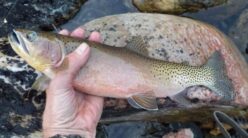Even if you know the terrain, the avalanche danger throughout Northern Utah and into Southeastern Idaho is high, and forecasters are encouraging those without the proper training to stay off slopes.
Toby Weed, a forecaster with the Utah Avalanche Center, said the current snowpack throughout the region is unstable. Numerous avalanches have been reported after the recent storms.
“Everyone wants to get on the ski slopes, you want to avoid the slopes and especially stay out from under them,” Weed said. “If you don’t have the terrain knowledge, just stay away.”
Since Dec. 23, five avalanche observations have been reported in the Logan area through the Utah Avalanche Center website. Weed said one of those avalanches was nearly fatal.
On Tuesday in the Boss Canyon area of Franklin Basin, a party of snowmobilers triggered a slide that carried one of the members away, burying him and pinning him against a tree. While Weed said he’s not clear on all the details, the snowmobiler was either fully or mostly buried, and it took the party 45 minutes to dig him out.
“He was not injured, although it was a really nasty close call,” Weed added.
Photos of the incident published on the UAC website show the heavily treed where the avalanche occurred. Two of the photos show other riders working to remove the trapped snowmobiler from the tree well.
Weed said another incident took place on Tuesday at the popular Rodeo Grounds area near Logan Peak. The snowmobile tracks show that the avalanche was triggered from below. Weed said it’s not always the snow beneath you that slides when you set off an avalanche.
“You can trigger them across an area,” Weed said. “It can be from below or a long distance away.”
The Rodeo Grounds slide was estimated to be nearly 60 feet wide and approximately a foot deep and was situated on the west side of “Prov Lake” near an elevation of about 9,400 feet.
Most slides are “slab avalanches,” where a weak layer of snow breaks under the weight of newer snow that has fallen or drifted on top. The weak layer and all the snow above it slides downhill, picking up speed extremely quickly.
Experts and recreationists watch out for certain patterns in the weather and in the snowpack’s structure itself to predict avalanche danger.
“There is really bad snow structure right now,” Weed said. “The two storms we got over Christmas deposited quite a lot of snow with about 4 inches of water weight. It is now a slab that is heavier and sitting atop weaker snow.”
Weed said the snow stabilizes over time, but the process is so gradual that it is hard for those who aren’t equipped to evaluate the slopes to know where the danger of human-triggered events is still high.
In the daily advisory on the UAC website for the Logan area mountains, Weed has placed the avalanche danger in the “Considerable” range, which indicates that human-triggered avalanches are likely.
“All the ones we see in the next couple of days will be triggered by people,” Weed said.
While out evaluating conditions Tuesday, Weed witnessed cracking along a trail in Steep Hollow indicating how unstable the snow is.
“People should look for cracking, which can be about two feet deep. Another thing to watch for is collapsing,”Weed said. “It is hard to hear when you are on a sled, but you can hear and feel the snowpack collapse below you.”
As more storms come through the area and outdoors enthusiasts head into the Bear River Mountains or other areas of the state, Weed cautions recreationists to make sure they are familiar with the terrain and have the proper equipment if tragedy strikes.
Overall, Weed says one of the most important things is to get educated about avalanche danger.
“For lay people it is really hard to judge,”Weed said. “Take an avalanche class to become more savvy.”
A listing of classes and seminars can be found on the UAC website, utahavalanchecenter.org.



